

 |
Search the Site with

|
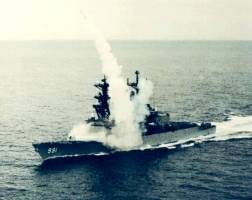 | 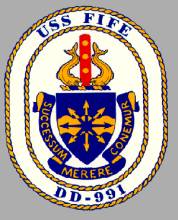 | 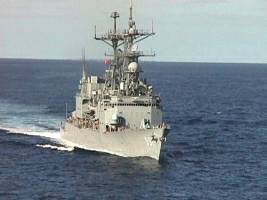 |
USS FIFE was the 29th of the 31 SPRUANCE class destroyers. Between June 27 and July 11, 2002, FIFE was the U.S. Task Group flagship for the Pacific Phase of the annual UNITAS exercise conducted with naval forces from five nations off the coast of Chile. The ship's five-month deployment to the Eastern Pacific Ocean for Counter-Drug Operations and the UNITAS exercise was the final deployment for the destroyer.
Last homeported in Everett, Wash., the FIFE was stricken from the Navy list on April 6, 2004, and sunk as a target during a live-fire exercise off Hawaii by the USS RUSSELL (DDG 59) on August 23, 2005.
| General Characteristics: | Keel Laid: March 6, 1978 |
| Launched: July 21, 1979 | |
| Commissioned: March 31, 1980 | |
| Decommissioned: February 28, 2003 | |
| Builder: Ingalls Shipbuilding, West Bank, Pascagoula, Miss. | |
| Propulsion system: four General Electric LM 2500 gas turbine engines | |
| Propellers: two | |
| Blades on each Propeller: five | |
| Length: 564,3 feet (172 meters) | |
| Beam: 55,1 feet (16.8 meters) | |
| Draft: 28,9 feet (8.8 meters) | |
| Displacement: approx. 9,200 tons full load | |
| Speed: 30+ knots | |
| Aircraft: one | |
| Armament: two | |
| Crew: approx. 340 |
Crew List:
This section contains the names of sailors who served aboard USS FIFE. It is no official listing but contains the names of sailors who submitted their information.
About the Ship's Coat of Arms:
 ( Click on the Coat of Arms for a larger version )
( Click on the Coat of Arms for a larger version )
The Crest:
The official crest of USS FIFE is highly symbolic of the ship's namesake, Admiral James Fife, Jr. Admiral Fife was an especially distinguished submariner. The dolphins, old maritime symbols, represent his career that included service in both Atlantic and Pacific Oceans during World Wars I and II. The dolphins are adapted from the submarine service badges and signify Admiral Fife's service.
The dolphins also symbolize USS FIFE's mission of anti-submarine warfare. The red torpedo alludes to Admiral Fife's submarine command during World War II; the red color denotes his active service during war. The three gold discs on the torpedo represent the three Distinguished Service Medals awarded to Admiral Fife for his exceptional service during the war.
The Shield:
The gold and dark blue of the shield are colors associated with the Navy and symbolize the sea and excellence. The shield is divided into three sections to represent the air, surface, and subsurface environments of naval warfare. The bursting bomb extends into all areas of the shield and signifies the versatility and striking power of USS FIFE.
The Motto:
The ship's motto, "SUCCESSUM MERERE CONEMUR", translates as "ENDEAVOR TO DESERVE SUCCESS".
USS FIFE's Commanding Officers:
| Period | Name |
|---|---|
| May 31, 1980 - September 15, 1981 | Commander John Y. Schrader, Jr., USN |
| September 15, 1981 - September 19, 1983 | Commander William S. Ulrich, USN |
| September 19, 1983 - January 8, 1986 | Commander L. P. Amborn, USN |
| January 8, 1986 - February 26, 1988 | Commander W. J. Keating, Jr., USN |
| February 26, 1988 - January 29, 1990 | Commander L. W. Bauer, Jr., USN |
| January 29, 1990 - February 20, 1992 | Commander C. A. Kemp, USN |
| February 20, 1992 - February 12, 1994 | Commander D. T. Vilotti, USN |
| February 12, 1994 - February 7, 1996 | Commander E. T. Wooldridge, USN |
| February 7, 1996 - December 15, 1996 | Commander A. B. Tamayo, USN |
| December 15, 1996 - January 24, 1997 | LCDR P. R. Kessler, USN |
| January 24, 1997 - September 18, 1998 | Commander C. A. Carpenter, USN |
| September 18, 1998 - April 5, 2000 | Commander S. H. Huber, USN |
| April 5, 2000 - October 1, 2001 | Commander J. E. Field, USN |
| October 1, 2001 - February 28, 2003 | Commander Fernandez L. Ponds, USN |
USS FIFE Cruise Books and Pamphlets:
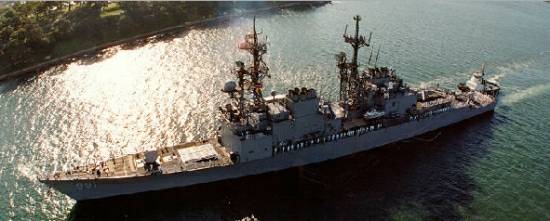
About the Destroyer’s Name, about Admiral James Fife, jr.:
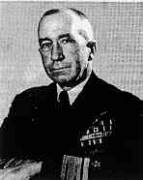 USS FIFE is named in honor of Admiral James Fife, Jr., an outstanding naval officer. He served in both World War I and World War II in submarines and surface combatants. He served in the Battleship IDAHO and the destroyers LEARY and HATFIELD from 1923 until May 1935.
USS FIFE is named in honor of Admiral James Fife, Jr., an outstanding naval officer. He served in both World War I and World War II in submarines and surface combatants. He served in the Battleship IDAHO and the destroyers LEARY and HATFIELD from 1923 until May 1935.
During World War II, Admiral Fife commanded Submarine Squadron 20 (under Admiral T. C. Hart) and after it was dissolved later into Submarines, Asiatic Fleet, he served as Chief of Staff to the Commander until May 1942. He served with General MacArthur as the representative of Admiral A. S. Carpenter during the Buna campaign.
Admiral Fife was awarded the Distinguished Service Medal for meritorious service as the Chief of Staff to Commander Submarines, Asiatic Fleet, the Air Medal (by the Army), and a Gold Star in lieu of a second Distinguished Service Medal for action in the Pacific area. During the last months of the war he served as Commander Submarines, Southwest Pacific; Commander, U. S. Naval Forces, Western Australia; and Commander Task Force 71. As a result, he was awarded a Gold Star in lieu of a Distinguished Service Medal.
From April 1947 until 1950, he commanded the Submarine Force, Atlantic Fleet. This assignment was followed by duty as Assistant Chief, and Deputy Chief of Naval Operations (Operations). His final assignment before retirement was as U. S. Naval Commander in Chief, Mediterranean, under Admiral Mountbatten, Royal Navy.
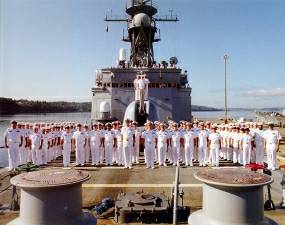
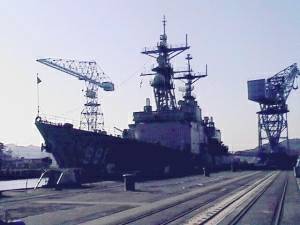
History of USS FIFE:
On March 6th, 1978 at the Ingalls Shipbuilding Division of Litton Industries in Pascagoula, Mississippi the keel was laid for USS FIFE, the 29th Spuance class destroyer.
Launched on July 21st, 1979 and sponsored by Mrs. Nancy Fife Prior, daughter of the ship's namesake Admiral James Fife Jr., the ship was commissioned on May 31st, 1980 and placed under the command of Commander John Y. Schrader, Jr.
Designed for modern antisubmarine warfare and to replace the many retiring World War II- era ships, the Spruance-class destroyer was intended to operate as a multi-mission warship either independently or in company with amphibious or carrier task groups. Powered by gas turbine engines and armed with antisubmarine rockets (ASROC), Harpoon and Sea Sparrow missiles and two 5-inch guns, FIFE possessed a technical superiority with her advanced SQS- 53 sonar and third generation naval tactical data system (NTDS).
FIFE was fitted out at Pascagoula, getting underway on March 6th, 1981 heading for the west coast and her assignment to the Pacific Fleet. She arrived in San Diego, California, on March 18th following a stop in Cartagena, Columbia. Shakedown system trials and crew training proceeded through the summer when the destroyer's first tasking came suddenly at the end of August. Departing San Diego on the 29th, she quickly steamed north to Alaska to conduct two weeks of surveillance on a Soviet Task Force operating in American waters. Returning to San Diego on September 22nd, FIFE conducted final weapon system tests and exercises in preparation for her first overseas deployment.
Heading west from San Diego on January 5th, 1982, FIFE joined several other ships and sailed from Pearl Harbor via Guam to Subic Bay, Philippines. She conducted numerous ASW exercises with the 7th Fleet in the South China Sea before a liberty port in Manila. Exercise "Team Spirit" in South Korea preceded war-at-sea evolutions with three American aircraft carriers as part of "READIEX 82" in April. Another brief stop in Subic Bay in May for upkeep was followed by liberty visits to Hong Kong and Japan before returning to San Diego on June 30th.
FIFE'S second overseas deployment began with "READIEX 83-4." Departing with the USS RANGER (CV 61) battlegroup on July 15th for the Persian Gulf, she alternated carrier escort duties with surveillance operations in the Gulf of Aden. While operating with the RANGER on
the 17th of November, a Soviet guided missile frigate closed the warships in violation of international agreements for preventing collisions at sea. Fortunately, FIFE suffered only minor damage from the resulting collision with the RAZYASHCHIY. In December, FIFE sailed south for a port visit in Mombassa, Kenya. While there, a cyclone passing over Agalegra in the Mauritius Islands caused massive destruction. FIFE, along with her SH-2F helicopter, provided aid transferring food and water ashore. During the return trip north, FIFE intercepted the Soviet aircraft carrier NOVOROSSIYSK and performed a brief period of surveillance before rendezvousing again with the RANGER battlegroup. Relieved by the USS MIDWAY (CV 41) battlegroup in January, the warships turned for home, arriving in San Diego on February 29th, 1984.
The following sixteen months were spent preparing for her next overseas deployment, with the warship's time split between local training operations, a series of overhaul periods at Long Beach (where she received new propeller blades, weapons, and electronics), and various propulsion plant inspections and pre-deployment refresher exercises. Following a Harpoon firing exercise in June 1985, the destroyer sailed for the Far East on July 24th. Following a brief stop in Subic Bay, the destroyer continued west through the Strait of Malacca to the Indian Ocean and an exercise with the Royal Singapore Navy.
The warship suffered its first mishap on September 1st when a UH-46 helicopter lost power on take-off, struck the NATO Seasparrow missile mount, leaving the stricken helicopter hanging over the ships' starboard side. Fortunately, FIFE's damage control teams quickly lashed the UH-46 in place and all 16 personnel were rescued without serious injury.
After pulling into Singapore to crane off the damaged helicopter, the warship sailed west to Diego Garcia to receive a new Seasparrow mount. In late September, FIFE steamed in the vicinity of Socotra in the Gulf of Aden to conduct surveillance operations against the Soviet Navy, a mission carried out again in the Red Sea during October. After port calls to Mombassa, Kenya, and Victoria, Seychelles, FIFE sailed for home on 13 November, arriving in San Diego on 21 December.
The fast pace of operations did not end upon her return. FIFE immediately began a hectic series of training evolutions, department inspections, and pre-overhaul preparations. These included the exercise "Kernel Blitz" in April 1986, propulsion exams in May and June and a command inspection in August.
The destroyer then entered Southwest Marine Shipyard for an extensive overhaul, commencing September 29th. During the yard work - which was interrupted in mid-February 1987 by bomb threats made by disgruntled shipyard workers - FIFE received numerous mission-expanding upgrades. The AN/SQ-89 sonar suite and the new LAMPS III helicopter system extended FIFE's ASW capabilities. The MK 41 Vertical Launching System (VLS) turned FIFE into a Tomahawk cruise missile strike platform. Two Phalanx Close-in Weapon System (CIWS) point defense weapons upgraded her self-defenses, and engineering plant and firefighting system modifications improved her overall war fighting capabilities. Following almost thirteen months of work, the destroyer carried out sea trials in November before returning to San Diego on December 14th.
In 1988, as part of a forward deployment strategy, FIFE changed homeports from San Diego to Yokosuka, Japan, arriving there on August 31st. During the first few months as the crew settled into their new home FIFE made several short excursions, including an ASW operation in October and port visits to Subic Bay and Hong Kong in November and December of 1988.
After a period in dry dock in Yokosuka to repair a crack in her sonar dome, FIFE put to sea in March of 1989 for surveillance operations against Soviet warships operating out of Vladivostok. On June 26th, while sailing in the South China Sea, FIFE spotted a distressed boat of Vietnamese refugees. Fifty-one refugees were rescued from the sinking vessel and provided with medical assistance and other care before being delivered to a United Nations refugee organization in Thailand a week later. The warship conducted a second cruise in the region in July, during which time she rescued another boat of refugees - this time 151 Vietnamese - before conducting exercises with Thai and Australian Navy ships.
Continuing west, FIFE sailed to the Persian Gulf and arrived there on September 19th. The warship steamed back east in October and, after a port visit to Fremantle, Australia, she sailed north for Yokosuka. An attempted coup in the Philippines diverted FIFE in early December, however, and she stood by for possible contingency operations until the crisis abated. FIFE returned to Yokosuka on December 11th.
FIFE began preparations for another Persian Gulf deployment after Iraq invaded Kuwait in August 1990. In addition to pre-deployment workups, FIFE successfully passed her Cruise Missile Tactical Qualifications, On October 2nd, FIFE sailed in company with the USS MIDWAY Battle Group Alpha to the Persian Gulf, arriving there on November 2nd. During Operation Desert Shield, FIFE helped enforce trade sanctions against Iraq as part of the Maritime Interception Force.
In mid-January of 1991, FIFE moved to the Northern Arabian Sea in preparation for launching Tomahawks as the U.N. deadline for an Iraqi withdrawal from Kuwait approached. On January 17th, FIFE launched 22 missiles against Iraq at the outbreak of Operation Desert Storm; the first of 60 Tomahawks launched over the next two weeks. After the last strike was carried out on January 31st, she rendezvoused with the USS TRIPOLI (LPH 10) and Amphibious Task Group
151.11, spending the next few weeks participating in minesweeping and feint operations in the northern Gulf off Kuwait. FIFE provided some assistance to TRIPOLI and USS PRINCETON (CG 59) after they suffered mine hits in February. Departing the Gulf on March 9th, the destroyer stopped at Pattaya Beach, Thailand, Singapore, Hong Kong, and Subic Bay, before returning to Yokosuka on April 17th.
Departing Japan again on April 15th, 1992, FIFE made liberty stops at Bali, Indonesia, Singapore, and Phukett, before arriving at Muscat, Oman, on May 19th. After transiting the Straits of Hormuz on May 24th, the warship came under control of the newly established Central Command in the Persian Gulf and helped enforce United Nations sanctions against Iraq. In company with the USS INDEPENDENCE (CV 62) battle group, FIFE sailed for home on September 17th and, following stops at Pattaya Beach and Hong Kong, arrived in Yokosuka on October 13th.
In October, FIFE entered Dry Dock 5 at Yokosuka for regular system maintenance and repair.
Work was complete in February 1994. After successful sea trials in early April, FIFE got underway on the 13th for an extended post-overhaul cruise into the southern Pacific waters. In May, the destroyer sailed on to Thailand, where she participated in Exercise "Cobra Gold" before returning to Yokosuka on June 1st.
Underway again on August 22nd, 1995, FIFE transited the Straits of Malacca on the 30th and, after catching up to the INDEPENDENCE Battle Group, arrived in Bahrain on September 9th. In a reprise of her last visit, FIFE assumed the duties of Ready Strike Platform in the northern Persian Gulf and carried out Maritime Interdiction Operations (MIO) as required. As part of the latter duties, FIFE'S Visit, Boarding, Search, and Seizure (VBSS) team uncovered thousands of
contraband automobile tires and batteries hidden in the Indian-flagged tramp AL SHAKEEL. This was the largest seizure in months and caused a shift in focus toward smaller ships and dhows previously overlooked. Although the INDEPENDENCE BG departed the area in October, FIFE remained on station owing to a shortage of strike platforms in the region. Departing the region on November 13th, FIFE steamed for home and arrived in Yokosuka on 7 December, following
stops at Phukett and Singapore.
On June 6th, during RIMPAC '96, FIFE helped protect INDEPENDENCE during the numerous war-at-sea exercises and attacks by "enemy" surface action groups and submarines. At one point, the Japanese warship YUUGIRI accidentally shot down an A-6 from INDEPENDENCE during a live-fire CIWS exercise. FIFE closed the area to help rescue both aviators and recover wreckage for analysis. The ship's crew ended the operation with a port visit in Pearl Harbor, a rare stateside visit for forward deployed naval forces.
FIFE returned to Japan in July and departed Japan on February 24th, 1997 for her next deployment, this time sailing south for exercises off Australia. After a stop in Guam to refuel, the ship arrived in the Coral Sea on March 14th. There, she joined Australian and other US ships for Exercise "Tandem Thrust '97" - a joint surface warfare evolution. FIFE then visited Hobart, Melbourne, and Esperance during a half-circumnavigation of Australia before stopping in Bali for three days of liberty. She moved on to Jakarta, Indonesia, in late April before steaming to Thailand for Exercise "Cobra Gold '97." After a final ASW exercise with the Japanese Navy in June, the warship moored at
Yokosuka on July 16th.
Following the ASW Exercise "Sharem 108-2" off Japan in late January 1998, FIFE sailed south to Darwin, Australia. Arriving there on February 18th, she participated in the anniversary ceremony of the bombing of Darwin during World War II. After returning home in March, FIFE's crew then loaded Tomahawk missiles for transit to Hawaii for maintenance. Her crew also prepared for a shift of homeport from Yokosuka to Everett, Washington. Departing Japan on April 9th, the warship stopped at Pearl Harbor to swap out missiles before steaming to Everett and mooring there on May 5th. After settling into her new homeport, the warship made preparations for her next deployment.
Embarking Helicopter Antisubmarine Squadron Light 49 (HSL 49) with an SH-60 helicopter and a Coast Guard boarding team, FIFE steamed south to the coast of Mexico on October 5th. There, she tracked suspect vessels and conducted boardings in support of counter-narcotic operations. The warship also coordinated patrols by P-3C and C-130 aircraft, which helped Mexican counter-narcotic aircraft to force down a suspect aircraft and capture half a ton of cocaine. FIFE returned to Everett on December 18th.
After her return, FIFE moved to Bremerton, Washington for restricted availability on October 13th, a period that would last until January 10th, 2000. Two weeks later she sailed south to San Diego for pre-deployment training operations. Those were interrupted by search-and-rescue efforts following the crash of Alaska flight 612 in early February. Departing Everett on March 31st, FIFE sailed west to the Persian Gulf via Pearl Harbor and Townsville and Darwin, Australia. She transited the Strait of Hormuz on May 19th and began sanction enforcement operations three days later. The warship departed the Gulf on August 2nd and, after stops in Phukett, Singapore, and Hong Kong, she returned once again to Everett on September 29th.
FIFE spent the remainder of the year preparing for her upcoming shipyard availability and started 2001 in Todd Shipyard Seattle, where, among other work, she received an upgrade to the Advanced Tomahawk Weapon Control System. She completed her training cycle on October 23rd, right after a change of Command where FIFE's final Commanding Officer was instated. FIFE then headed south on a six-week surge to South America where she seized 600 pounds of cocaine before returning to homeport on December 14th.
After splitting the winter between Everett and San Diego, FIFE geared up for her final deployment. On May 20th, 2002, FIFE departed from Everett and headed south for six months off the coast of Central and South America. Taking along HSL 47 Detachment 3, as well as a Coast Guard law enforcement detachment (LEDET), FIFE began the deployment with a few weeks of counter-narcotics operations, during which time she located a vessel loaded with illegal migrants from Ecuador. The vessel was intercepted and escorted to Guatemala where it was turned over to authorities. In July, FIFE embarked Commander, Destroyer Squadron 14, and served as the US Flagship in the Chilean-sponsored UNITAS 43-02 Pacific Phase exercises. A month of training and exercises with five different Central and South American navies culminated in a full-scale three-day war-at-sea exercise.
Upon the conclusion of the UNITAS exercises, FIFE participated with the submarine forces of Peru in the Silent Forces Exercise (SIFOREX). Through sixteen ASW exercises, FIFE demonstrated her ASW prowess, and was not "sunk" by the enemy forces.
For the last four months of FIFE's final deployment she continued with her counter-narcotic mission. Nine suspected drug smugglers were detained, and over two tons of cocaine were recovered. All told, FIFE interdicted over $900 million dollars worth, as well as making the largest bust of illegal shark fin on record - $6.5 million.
FIFE returned to Everett on November 20th and hegaji making preparations for decommissioning. On February 28th, 2003, FIFE was decommissioned after 22 years of dedicated service to her country.
Accidents aboard USS FIFE:
| Date | Where | Events |
|---|---|---|
| November 17, 1983 | Arabian Sea | The Soviet Krivak I-class guided missile frigate RAZYASHCHIY collides with USS FIFE in the North Arabian Sea causing minor damage to the FIFE but no injuries. Reportedly the RAZYASHCHIY attempted to approach the USS RANGER (CV 61). When FIFE attempted to head off the Soviet ship, the two ships grazed hulls, leaving two 15-foot scrapes in the FIFE's paint. |
| September 1, 1985 | Pacific | A UH-46 helicopter loses power on take-off, hits the NATO Seasparrow missile mount, leaving the stricken helicopter hanging over the ships' starboard side. FIFE's damage control teams quickly lashed the UH-46 in place and all 16 personnel were rescued without serious injury. The FIFE subsequently proceeds to Singapore to crane off the damaged helicopter. Later, FIFE sails west to Diego Garcia to receive a new Seasparrow mount. |
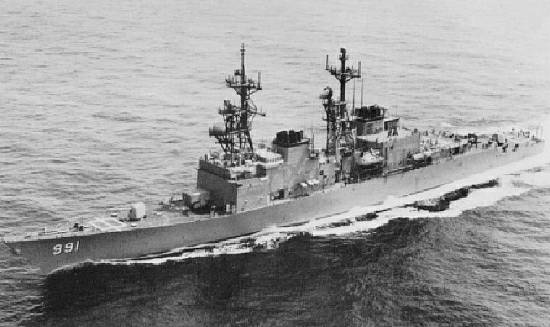
USS FIFE Patch Gallery:
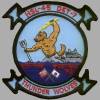 |
USS FIFE Videos:
The video below is a sad but also impressive documentation of the sinking of USS FIFE. The video consists of a series of photos, followed by video scenes and again some photos. The video includes two hits from Mk-48 torpedoes and several gunfire impacts. The torpedoes ripped off FIFE's bow section. At the end of the video one can also see the sinking of the "OLMENDORF" which is actually FIFE's sistership OLDENDORF (DD 972).
USS FIFE Image Gallery:
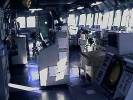 |  | 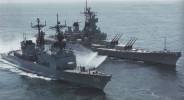 | 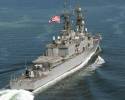 | 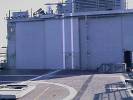 |
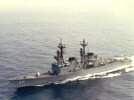 | 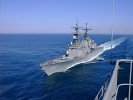 | 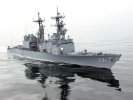 | 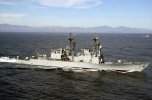 | 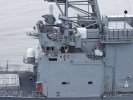 |
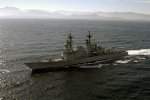 |
 Back to Destroyers list.
Back to Destroyers list.  Back to ships list.
Back to ships list.  Back to selection page.
Back to selection page.  Back to 1st page.
Back to 1st page.